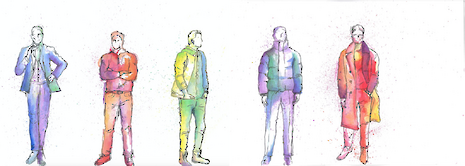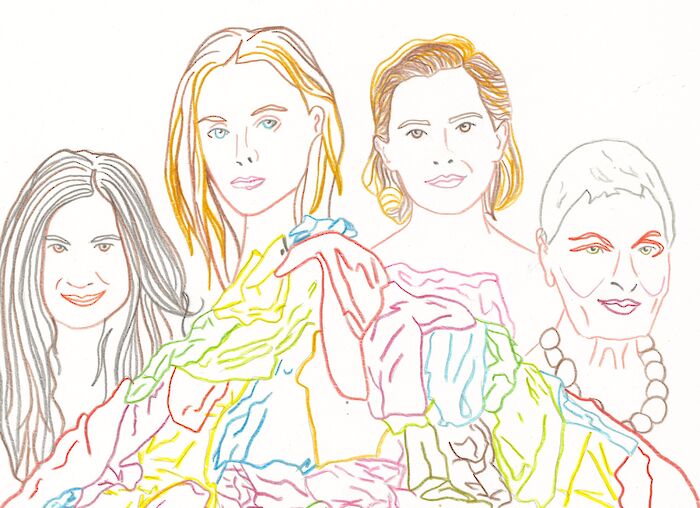Fashion: a man’s world?
Caterina Bragoli talks to two male students about the role fashion plays in their lives.

In clothing, we are increasingly challenging the claustrophobic restrictions of gendered expectations.
Women in particular are targeted by a torrent of beauty ideals and conventional body types, with modern-day feminism acting somewhat as a counterweight to this pressure. However, we are rarely offered a glimpse into the problematic standards that men face in a similar climate of hypermasculinity. I spoke to Cambridge students Matt and Dan, who shed light on the progression of the male ideal standard to a less restrictive, more all-embracing image.
The fashion industry has become inextricably associated with the female gender. This pairing surfaces in the main event of the fashion calendar: Fashion Week. It consists of brands showcasing predominantly female-orientated collections, while the earlier ‘Men’s Fashion Week’ draws significantly less attention.
The reality of what we choose to wear is often quite the contrary: without gender boundaries, fashion can act as a crucial mode of self-expression for young men globally. “My relationship with clothes is like they almost become a part of me,” says Matt, linking specific items to specific memories, like music festivals.
Clothing seemingly has an ability to retain important moments. “The nice feeling of having a new item of clothing and wearing it in and for it slowly to become part of you,” is something Dan expresses to be of equal importance. When we take an item of clothing beyond face value, the most unlikely garments can merge with moments or feelings, creating something that transcends aesthetics.
The unique pieces that assist in shaping an intricately personal wardrobe can often be sourced away from the tumult of fast fashion and high-street retail.
Both students opt for charity shops as a way of locating pieces with a sense of history to them, whilst also endorsing a more ethical shopping approach. A hoodie from a charity shop in Leeds, seemingly nothing of note, is given a new meaning by appreciating its small elements. “Just as the point where I saw this as my hoodie, I realised the label said someone else’s [name] and someone else would have the same identity associated with this item of clothing”, notes Dan. Clothing is important in its ability to capture and preserve personality and memory in unison – something that helps build an identity for young men too.
It is crucial to consider aspects of the fashion industry that are rarely voiced. Social media’s tendency to flood images of impossible and unattainable female perfection is of equal relevance when assessing problematic male beauty standards.
The conversation generated around beauty standards is largely directed towards women, while neglecting vital problems from an alternative angle. A similar culture of conforming to the established hypermasculine ideal has been gradually cultivated over time, as author Michael Ian Black wrote in a New York Times article last year, entitled ‘The Boys Are Not All Right’.
“The past 50 years have redefined what it means to be female in America… Boys, though, have been left behind. No commensurate movement has emerged to help them navigate toward a full expression of their gender.”
It is time to readdress the balance, and spotlight pressing issues. Matt echoes Black’s sentiment when speaking of male beauty standards: “It’s so incessant, like a bombardment, an image which makes you want to be more than you are always.” By presenting a pre-conceived perception of masculinity, society is fostering an exclusive ideal that serves to alienate most young men.
Social media plays a fundamental role in this ceaseless tirade. Social media essentially has become an archive of images and campaigns that often endorse the same, specific body type and skin colour. Streamlining a diverse population into one image is undeniably going to have severe repercussions.
“No commensurate movement has emerged to help [men] navigate toward a full expression of their gender”
That being said, is our online world the key issue? “Partly because of social media, we can all live in our own worlds; we see the same images and they are projected onto you because you’re their target demographic”, says Dan, accounting for the fact that we can often greatly influence our personal experiences with social media.
“I don’t see that many male representations that aren’t already catered towards my interests,” he continues. This leads me to ask, is social media in this way helping subvert traditional modes of advertisement, reducing the impact of specific male beauty standards as we show less interest in them?
Undeniably, it’s also culture that fosters a hypermasculine body image. “With male body image expectations, it’s not like that exists in a vacuum and isn’t disconnected from problematic male behaviours and attitudes towards women,” comments Matt.
The heteronormative roles that society requires binary genders to adopt are fraught: long-established hierarchical positions have filtered through into the fashion and beauty industries. Of course, this has shaped the way men are portrayed. However, these heteronormative ideals are being challenged, thus altering the way in which men are perceived.
“I think it’s changing because of #MeToo. I think there’s more value being placed on the understanding, empathetic male role than before.” Dan’s emphasis is on the role of recent campaigns challenging problematic expectations or behaviours that may have been normalised. When society praises qualities like empathy, sensitivity and gentleness – things missing from heavily ingrained, overly-macho conceptions of masculinity, the idea of what it means to be a man evolves, influenced by the evolving socio-political climate.
Despite the ushering in of change, the process of altering such a cemented aspect of society is challenging when some men feel silenced. “There’s this whole masculine issue of being tight-lipped and not talking about this”, says Matt.
This “tight-lipped” trait that some men feel pressured to adopt stems from historic conceptions of hypermasculinity, yet as this image changes, voices are starting to be heard. “If none of these issues are talked about they fester under the surface and become problematic”, concludes Matt. Generating conversation and sharing experiences of such tentative topics invites progression, and this is a response that needs to be widely recognised.
Can problematic male beauty standards compare to the untold levels of pressure that women face? “I do think with men there’s more variance on what society says you can be, as with women there’s fewer archetypes,” comments Dan. Yet, this idea is debatable. 80.7% discuss their bodies with specific reference to anxiety or dysmorphic-inducing aspects, in comparison to 75% of women.
Whilst the common consensus amongst these two young men is that women have a far harder time – Matt feels that “there are such intense beauty standards for women that don’t exist for men” – maybe such opinions are products of a society that endorses such stringent masculine roles. We can do more to address the underlying problems that occur for men. It is undeniable that women are facing the consequences of damaging ideals, although the experiences of young men shouldn’t be neglected.
“There needs to be more of an investigation into male beauty ideals,” concludes Dan, prompting a broader discussion. Traditional male gender roles, and the way that this feeds into the fashion and beauty industries, are evolving: our progressive social climate will question conformity and for a more accepting standard, representative of more than one solitary ideal.
 Comment / Plastic pubs: the problem with Cambridge alehouses 5 January 2026
Comment / Plastic pubs: the problem with Cambridge alehouses 5 January 2026 News / Cambridge businesses concerned infrastructure delays will hurt growth5 January 2026
News / Cambridge businesses concerned infrastructure delays will hurt growth5 January 2026 News / Cambridge academics stand out in King’s 2026 Honours List2 January 2026
News / Cambridge academics stand out in King’s 2026 Honours List2 January 2026 Interviews / You don’t need to peak at Cambridge, says Robin Harding31 December 2025
Interviews / You don’t need to peak at Cambridge, says Robin Harding31 December 2025 News / AstraZeneca sues for £32 million over faulty construction at Cambridge Campus31 December 2025
News / AstraZeneca sues for £32 million over faulty construction at Cambridge Campus31 December 2025










